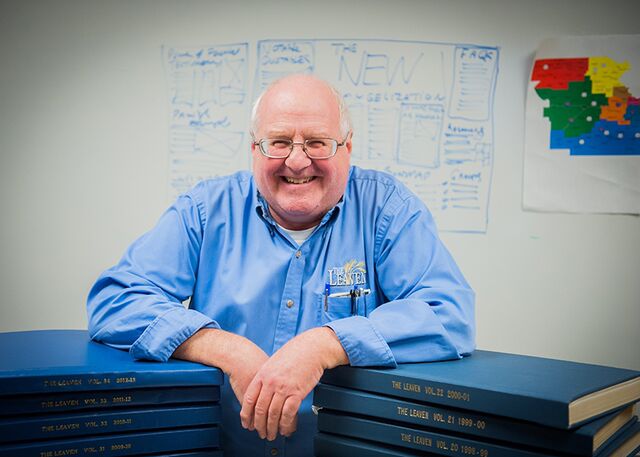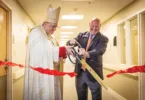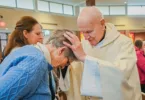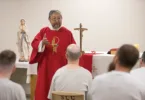
St. John the Baptist was more than just a church; it was the community on Strawberry Hill. Father Mark credits that dynamic community with helping him discover his vocation to the priesthood.
Father Mark Goldasich has brought The Leaven to lofty heights in his 25 years of service to the paper
by Todd Habiger
todd.habiger@theleaven.org
At a priests’ retreat in the late spring of 1986, a young Father Mark Goldasich felt like he was playing a game of hide- and-seek with Archbishop Ignatius J. Strecker. He wasn’t entirely sure the archbishop was actually looking for him, but he sure didn’t want to find out.
“We priests always walked in packs because, if you didn’t, Archbishop Strecker would go after the stray and you would get moved to a different parish,” Father Mark said.
Father Mark didn’t want to be moved. He liked his assignment as an associate pastor at St. Agnes Parish in Roeland Park. What he did want that day was a salad and, not thinking, he left the safety of the pack and headed to the salad bar. That’s where Archbishop Strecker caught up with him.
“How would you like to be editor of The Leaven?” he asked.
“I was shocked at that,” said Father Mark. “But it was hard to keep a straight face, because Father Bill Maher, who was editor at the time, was standing behind the archbishop looking at me, waving his keys, pointing and laughing.”
Father Mark accepted the assignment — after a year’s apprenticeship under Father Maher, and two years in Rome to study moral theology. In June of 1989, he officially became editor. Twenty-five years later, he’s still there.
Starting out
Mark Goldasich grew up on Strawberry Hill in Kansas City, Kansas, the only child of Carl and Angeline Goldasich. Strawberry Hill was a close-knit neighborhood with deep Croatian roots. Close-knit both figuratively and literally.
“We always used to kid that if you didn’t like what you were eating at your house, you could just reach through the window into the neighbor’s house and grab something off their table. [The homes] were that close,” said Father Mark.
“It was a great life,” he continued. “Very basic. Simple. Our life revolved around our relatives and the parish.”
That parish was St. John the Baptist and it was the community.
“The life of the parish was woven into daily life,” said Father Mark. “If you went bowling, it was Tuesday night at the parish. If there was a dance, it was at the parish. If you played in the orchestra, the performance was at the parish. The parish was a link to everything.”
On Strawberry Hill, grandparents, parents and children lived a few blocks from one another. Neighbors weren’t casual acquaintances — they more than likely had gone to school together and grown up together into adulthood.
“When I was ordained, I was ordained in my home parish. It wasn’t in front of a group of strangers wondering who this kid was,” said Father Mark. “I grew up with these people. They knew me since my birth.”
Planting the seed
For Father Mark, there wasn’t one moment that led him to the priesthood. In a sense, each event in his life seemed to point to that vocation.
“We had really good priests growing up,” said Father Mark, “really dedicated guys at my home parish. And they didn’t switch parishes. Death switched them.”
There was also an order of nuns that taught at St. John the Baptist School and ran St. John’s Orphanage. The School Sisters of St. Francis of Christ the King out of Lemont, Illinois, were Croatian and Slovenian nuns that had served St. John since 1909.
One in particular, Sister Praxeda, saw something in young Mark as early as kindergarten.
“We had a contest,” said Father Mark. “The contest was whoever was the best behaved boy and the best behaved girl would get a gift at the end of the week.
“I remember I was so good, Mother Teresa would have looked like a delinquent next to me.”
Naturally, he won the contest. His gift was a chalice set. In it was a small chalice that was a plastic wine glass wrapped in gold foil, a plate — again wrapped in foil, a “host,” a paten, a purificator, a corporal and a green cover over the whole set, symbolizing Ordinary Time.
“I thought that was the neatest thing,” said Father Mark. “Maybe that’s what planted the seed way back then.”
Following the call
Mark continued to follow the path toward the priesthood following elementary school. While most of the gang at St. John went to nearby Bishop Ward High School, Mark chose Savior of the World Seminary, in the western part of Wyandotte County.
“Those Savior years were very good,” he said. “There were great priests there, and great teachers. It was a great community.
“There weren’t that many of us. At the peak when I was there, maybe there were 100 guys. But we’re still close today.”
From Savior it was on to the College of St. Thomas in St. Paul, Minnesota. St. Thomas was a liberal arts college, but housed on its grounds in a dorm building was St. John Vianney Seminary.
At St. Thomas, Mark attended classes with students that weren’t on the track to become a priest. He dated, partied, and lived a pretty normal college life. But in the end, something always kept him on the path to the priesthood.
“I always felt very comfortable coming back to the seminary,” said Father Mark. “I felt comfortable at morning and evening prayer. I felt comfortable at Mass. It just felt right.”
After graduating from St. Thomas, Mark went to the Pontifical North American College in Rome to complete his final years of seminary. After finishing his studies at Rome’s Jesuit-run Gregorian University, Deacon Mark flew back to the United States to be ordained. Before returning to Kansas City, however, he made a pit stop in Lemont to visit his former kindergarten teacher, who was suffering from dementia.
“The superior of the order said she was in and out,” said Father Mark. “She said she might be really with it or she may not make any sense at all.
“I went into her room and it was one of those days when she was sharp as a tack. I said, ‘Sister, do you remember me?’
“Right away she said, ‘Mark Goldasich.’”
The young deacon went on to have a nice visit with her, telling the nun that he would be ordained a priest soon and recounted the story of her giving him the chalice set and how much it meant to him.
“She said, ‘I’m going to tell you a secret,’” recounted Father Mark.
“‘You would have gotten that [chalice set] no matter what.’”
Father editor
When he took over as editor of The Leaven in 1989, Father Mark had no journalism experience whatsoever. He also inherited an associate editor, Anita McSorley, who had only been in the position for a year and was herself short of journalism experience, having worked in the corporate world in New York prior to becoming associate editor.
“It was an interesting dynamic, that’s for sure,” McSorley said. “I think we were actually fortunate that neither of us had any real journalism experience. I came from a background of editing, but of books and magazines. And Father Mark was already known for his storytelling style.
“So we never felt constrained by what was then still a very formal, tradition-bound set of journalistic rules. We just tried to figure out what our readers wanted and needed to know, and then tried to deliver it in as engaging a fashion as possible.”
Father Mark said that early on he and Anita tried to flesh out what they felt was missing from Catholic journalism and fill that void.
“We wanted to inspire people to take the gifts they have and put those at the service of other people,” said Father Mark. “That’s not just Catholics doing Catholic things, but Catholics doing wonderful things.”
The results have been impressive. Under Father Mark’s leadership, The Leaven has won 140 Catholic Press Association awards.
“Early on, we didn’t get any,” said Father Mark. “As we started to get awards, it bumped things up for all of us here. It told everybody, from our writers to our photographers to our designers, that we were doing great work here. It’s been an inspiration for them to keep that quality high.”
While Father Mark is fond of telling people that his main job is to get out of people’s way, McSorley says that’s hardly the case.
“First,” she said, “Father Mark is only here three days a week, but on those days he’s a working journalist. When push comes to shove, and it sometimes has, he is capable of the entire range of tasks that need to be done to produce this paper.”
But his contribution is not only a practical one.
“If I had to identify one thing that makes The Leaven different from other diocesan papers, it’s the fact that it has a personality,” she said. “Now, I don’t think a lot of diocesan newspapers can claim that, but our paper can, and it comes by it honestly: Father Mark truly has one of those larger-than-life personalities, and it has imbued the paper.
“Now, he can be a demanding taskmaster at times,” she said, “and woe to the poor managing editor who lets a sub-par story slip in.
“But his sense of humor, his inquisitive nature, and his pastor’s heart are much of what makes The Leaven, The Leaven.”
Every thought
Father Mark likes to joke that every thought he’s ever had eventually winds up in his column, “Mark My Words.” While that may be a slight exaggeration, it’s not too far from the truth. To date, including this issue, Father Mark has written 1,032 columns as editor.
“Every week, my mind is like a sponge, absorbing new ideas,” said Father Mark. “Always in the back of my mind is a little voice that says, ‘Don’t forget you’ve got that column.’”
And very little is off-limits.
“My mom basically doesn’t talk to me anymore because she’s afraid it will be in a column if she says anything funny,” said Father Mark with a laugh.
Even Archbishop Joseph F. Naumann admitted at a recent event honoring Father Mark for his 25 years of service to The Leaven that “Mark My Words” probably surpasses his own column in terms of popularity.
“Father Mark is the Erma Bombeck of the Catholic press,” said McSorley. “He’s funny, he’s self-effacing, and at the heart of each of his columns you’ll find something to take home and chew on a bit. Readership surveys show his column is our single most widely read item in the paper.
“That used to drive me crazy,” admitted McSorley, “since no matter what I did or wrote, my own mother would go read Father Mark’s column first.
“Now? Now, I am grateful every day to be working for Erma.”
Father Mark has never lost his passion for storytelling. He likes to keep his columns grounded in everyday life and is not above poking fun at himself to stress a point.
“I hope that through my columns, people know me better, because I try to be as honest as I can about my joys in life, but also with my struggles,” he said. “I bring those things up and let people know that just because you’re a priest doesn’t mean you don’t have issues that you deal with.”
In looking back over past columns, Father Mark said he realizes how much his personal history has affected him in a positive sense.
“Whether it’s Strawberry Hill, a school I’ve gone to, Rome, or parishes I’ve been at,” he said, “there’s just so many people that have been a part of the fabric of my life.
“I feel very privileged to be able to tell those stories.”
Despite churning out over 1,000 columns, Father Mark isn’t worried about the well running dry.
“As long as there’s a world out there, there is stuff to write about,” he said.
Lasting legacy
The archdiocesan newspaper has been around for 75 years. As the editor for one-third of the papers the archdiocese has produced, it’s not a stretch to say that Father Mark has indeed left his mark on the paper.
While he wants The Leaven to be thought-provoking, he insists that it be readable by everyone. As he’s editing, right in front of him is a poster that says: “The man who knows what he is talking about can afford to use words everyone can understand.”
“At The Leaven we try to use language that people understand,” he said. “We don’t use jargon or highfalutin’ language. We give the information in an accessible way and we try to do it in a way that people understand and can take with them.”
Because, in the end, it isn’t awards or approval from readers that matters, he said. It’s saving souls.
“We are called to evangelize,” said Father Mark. “If we can inspire people through the paper with what we write to be better Catholics, then we are doing our job.”






